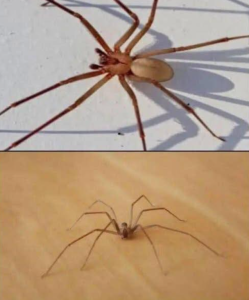Be Careful! This Spider Will Harm You With Just One Bite
They creep in corners, nest in shoes, and scurry silently in the shadows of our homes — most of them harmless, even helpful. But among the vast web of eight-legged creatures, a few are dangerously venomous, and one in particular stands out for its ability to cause serious harm with a single bite.
Meet the Brown Recluse Spider (Loxosceles reclusa), a small, unassuming arachnid that has earned an outsized reputation as one of the most dangerous spiders in North America. Its bite may not be instantly lethal, but the effects can be devastating — and in rare cases, even deadly.
Let’s explore what makes the Brown Recluse so dangerous, how to recognize it, where it hides, and most importantly — how to protect yourself and your loved ones from an unexpected encounter.
The Spider That Lives Up to Its Name
As the name suggests, the Brown Recluse is a shy and solitary spider, preferring dark, undisturbed spaces. It’s found most commonly in the southern and central United States — from Texas and Oklahoma to Georgia and parts of the Midwest — though reports of its spread continue to grow.
Despite its low profile, the Brown Recluse is known to cause a disproportionately high number of medically significant spider bites, largely due to its proximity to human dwellings.
Its reclusive nature makes it hard to spot, which is part of the danger: you may not even realize there’s one in your home — until it’s too late.
How to Identify a Brown Recluse Spider
Recognizing this spider could be lifesaving. Here are some key features to help you spot one:
- Color: Light to medium brown, sometimes with a slightly yellowish or grayish tint
- Size: About the size of a U.S. quarter (including the legs)
- Markings: A distinctive violin-shaped mark on its back, with the neck of the violin pointing toward the rear
- Eyes: Unlike most spiders which have eight eyes, the Brown Recluse has only six eyes, arranged in pairs
- Legs: Long, slender legs with no spines (but fine hairs)
Be cautious — many harmless spiders resemble the Brown Recluse, and misidentification is common. However, if you spot one in your home, especially in an area known for Brown Recluse sightings, do not attempt to handle it.
The Bite: Small Fang, Big Consequences
Brown Recluse venom is necrotic, meaning it destroys tissue. While some bites are minor and heal without intervention, others cause serious skin damage, and in rare cases, systemic symptoms that can be life-threatening.
What Happens After a Bite:
- Initial bite: Often painless or feels like a pinprick.
- Within 2-8 hours: Pain, redness, swelling.
- After 12-24 hours: A blister may form at the bite site, followed by tissue breakdown and an ulcer.
- After 1-3 days: In severe cases, the bite becomes a deep, necrotic wound that takes weeks or months to heal.
Severe reactions are more likely in children, the elderly, or those with compromised immune systems. Systemic symptoms may include:
- Fever
- Chills
- Nausea
- Joint pain
- Hemolysis (destruction of red blood cells)
- Kidney failure (rare but serious)
Real-Life Cases: When a Bite Turns Deadly
Though fatalities are extremely rare, severe complications do occur. One documented case involved a young child in Missouri who developed severe hemolytic anemia after being bitten. The child required hospitalization and blood transfusions.
In another instance, a 45-year-old man ignored what he thought was a harmless bug bite. Within days, a necrotic wound the size of a silver dollar formed on his thigh. He underwent multiple debridement procedures and months of wound care.
These cases underscore a critical truth: the Brown Recluse should never be underestimated.
Where Do Brown Recluses Hide?
Brown Recluses thrive in dark, undisturbed places, both indoors and outdoors. Common hiding spots include:
Indoors:
- Behind furniture
- In cardboard boxes
- Inside shoes or clothing not worn for a while
- Under beds and in closets
- Attics, basements, and garages
Outdoors:
- Under logs or stones
- In woodpiles
- Inside sheds or outdoor storage bins
Unlike other spiders, they’re not web-spinners in the open — instead, they create small, irregular webs in hidden corners, often as retreats rather than traps.
How to Prevent Brown Recluse Infestation
If you live in an area known for Brown Recluses, here are preventive steps you can take:
- Shake out shoes, clothes, and towels before use, especially if they’ve been unused for a while
- Store items in plastic containers, not cardboard boxes, which spiders love
- Seal cracks and crevices around your home, especially in basements and attics
- Use sticky traps in corners or near baseboards to monitor spider activity
- Declutter storage spaces and avoid piles of clothing on the floor
- Hire a pest control expert if you suspect infestation
What to Do If You’re Bitten
If you believe you’ve been bitten by a Brown Recluse:
- Clean the area with soap and water
- Apply a cold compress to reduce swelling
- Keep the affected limb elevated
- Avoid using heat (this may spread the venom)
- Do not attempt to suck out the venom
- Seek medical attention, especially if:
- The wound becomes worse over 24–48 hours
- You develop fever or other systemic symptoms
- You are a child, elderly, or immunocompromised
There is no definitive antivenom for Brown Recluse bites, but treatment may include:
- Antibiotics (if secondary infection occurs)
- Pain relief
- Wound care
- Surgery in extreme cases
Conclusion: Knowledge Is Protection
The Brown Recluse is a silent but serious threat, especially in regions where it’s common. While it won’t chase or attack humans, accidental encounters are enough to cause dangerous bites.
Understanding its appearance, behavior, and habitat can help you avoid becoming a victim. And if the worst happens, early medical attention can mean the difference between a mild reaction and a long, painful recovery.
Remember: not every spider is dangerous — but when it comes to the Brown Recluse, caution is essential.
Stay alert. Stay informed. And shake out those shoes.


